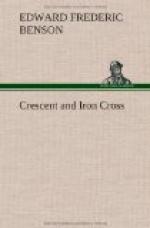But Southern Mesopotamia is a totally different proposition. The land lies low between the rivers, and, though of unparalleled fertility, yields under present conditions but a precarious livelihood to its sparse population. For nine months of the year it is a desert, for three months when its rivers are in flood, a swamp. Once, as we all know, it was the very heart of civilisation, and from its arteries flowed out the life-blood of the world. Rainfall was scarcely existent, any more than it is existent in Southern or Upper Egypt; but in the days of Babylon the Great there were true rulers and men of wisdom over these desiccated regions, who saw that every drop of water in the river, that now pours senselessly through swamp and desert into the sea, was a grain of corn or a stalk of cotton. They dug canals, they made reservoirs, and harnessed like some noble horse of the gods the torrents that now gallop unbridled through dreary deserts. The black land, the Sawad, was then the green land of waving corn, where three crops were annually harvested and the average yield was two hundredfold of the seed sown. The wheat and barley, so Herodotus tells us, were a palm-breadth long in the blade, and millet and sesame grew like trees. And in these details the revered Father of Lies seems to have spoken less than the truth, for the statistics we get elsewhere more than bear out his accounts of its amazing fertility. From its wealth before his day had arisen the might of Babylon, and for centuries later, while the canals still regulated the water supply, it remained the granary of the world. More than a thousand years after Herodotus there were over 12,500,000 acres in cultivation, and the husbandmen thereof with the dwellers in its cities numbered 5,000,000 men. Then came the Arab invasion, which was bad enough, but colossally worse was the invasion of the Osmanli. Truly ’a fruitful land maketh He barren, for the wickedness of them that dwell therein.’
But the potentiality for production of that great alluvial plain is not diminished; the Turks could not dispose of that by massacre, as a means of weakening the strength of their subject peoples. It is still there, ready to respond to the spell of the waters of Tigris and Euphrates, which once, when handled and controlled, caused it to be the Garden of the Lord.
Not long before the present European War Sir William Willcocks, under whose guidance the great modern irrigation works at Assouan were constructed, was appointed adviser to the Ottoman Ministry of Public Works, and his report on the Irrigation of Mesopotamia was issued in 1911. He tells us that the whole of this delta of the Sawad is capable of easy levelling and reclamation. It would naturally be a gigantic scheme, and he takes as a basis to start on the question of the refertilisation of 4,000,000 acres. Into the details of it we need not go, but his conclusions, calculated on a thoroughly conservative basis, give the following results. He proposes to restore, of course with modern technical improvements, the old system of canals, and, allowing for interest on loans, estimates the total expense at L26,000,000 (or the cost of the war for about three days). On this the annual value of the crops would pay 31 per cent. The figures need no enlargement in detail and no comment.




